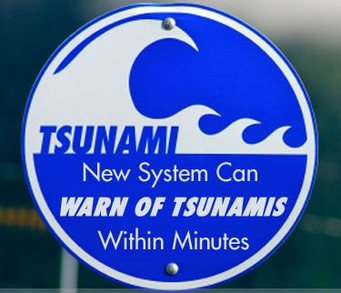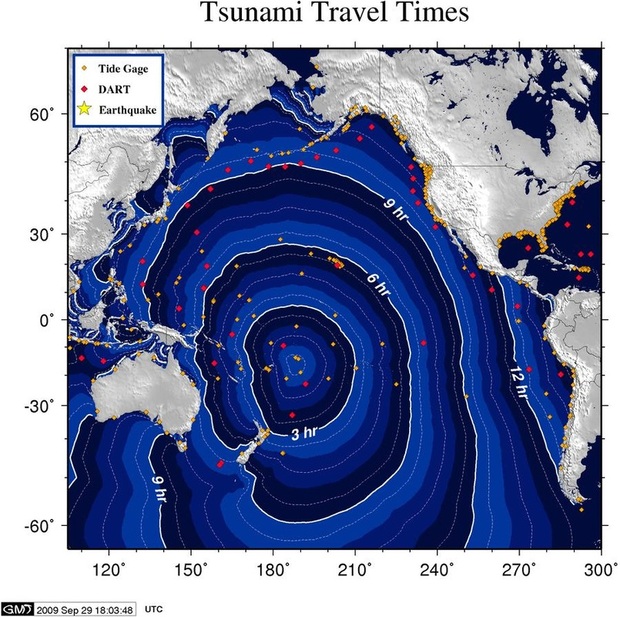 (A2) Seismologists have developed a new system that could be used to warn future populations of an impending tsunami only minutes after the initial earthquake. The system, known as RTerg, could help reduce the death toll by giving local residents valuable time to move to safer ground. The study by researchers at the Georgia Institute of Technology appears in the March 5 edition of Geophysical Research Letters. "We developed a system that, in real time, successfully identified the magnitude 7.8 2010 Sumatran earthquake as a rare and destructive tsunami earthquake. Using this system, we could in the future warn local populations, thus minimizing the death toll from tsunamis," said Andrew Newman, assistant professor in the School of Earth and Atmospheric Sciences. Typically, a large subduction zone earthquake ruptures at a rate near 3 kilometers/second and anywhere from 20 kilometers to 50 kilometers below the earth's surface. Because of the depth, vertical deformation of the crust is horizontally smoothed, causing the size of uplift to remain rather small. When these earthquakes occur in the ocean, the resulting waves may only measure about 20 centimeters high for a magnitude 7.8 event.  [Image Above: Tsunami earthquakes typically rupture more slowly, last longer and are less efficient at radiating energy, so when RTerg uses its algorithmic tools to find a quake matching these attributes, it sends an alert to the National Oceanic and Atmospheric Administration's Pacific Tsunami Warning Center as well as the United States Geological Survey's National Earthquake Information Center.] Tsunami earthquakes, however, are a rare class of earthquakes that rupture more slowly, at 1-1.5 kilometers /second and propagate up to the sea floor, near the trench. This makes the vertical uplift much larger, resulting in nearby wave heights up to 10- 20 meters in nearby coastal environments. Such is the case of the Sumatran earthquake with reported wave heights of up to 17 meters, causing a death toll of approximately 430 people. "Because tsunami earthquakes rupture in a shallow environment, we can't simply use a measurement of magnitude to determine which ones will create large waves," said Newman. "When they occur, people often don't feel that they're significant, if they even feel them in the first place, because they seem like they're an order of magnitude smaller than they actually are." Tsunami earthquakes typically rupture more slowly, last longer and are less efficient at radiating energy, so when RTerg uses its algorithmic tools to find a quake matching these attributes, it sends an alert to the National Oceanic and Atmospheric Administration's Pacific Tsunami Warning Center as well as the United States Geological Survey's National Earthquake Information Center. Here's how it works: Usually within four minutes, RTerg gets a notification from one of the tsunami warning centers that an earthquake has occurred. This notice gives the system the quake's location, depth and approximate magnitude. If the earthquake is determined to be of magnitude 6.5 or higher, it takes about a minute to request and receive data from around 150 seismic stations around the world. Once it collects this data, it uses its algorithm to run through every second of the rupture and determine the incremental growth of energy and ascertain whether the quake was a tsunami earthquake. Newman and his team have used seismology readings from previous tsunami earthquakes, such as the one in Nicaragua in 1992 and the one that hit Java in 2006, but the Sumatran event was the first tsunami quake that occurred when RTerg was online in real time. With that quake, the system identified the event as a potential tsunami earthquake after eight and a half minutes, and sent a notification out shortly thereafter. When applied to a production warning system, the tool will be most valuable, since analysts are available 24/7 to evaluate the algorithm results.
"For most tsunami earthquakes, inundation of the coastal environment doesn't occur until about 30-40 minutes after the quake. So we'll have about 20-30 minutes to get our information to an automatic warning system, or to the authorities," said Newman. "This gives us a tangible amount of time to get people out of the way." Currently, Newman and his team are working to test and implement a technique for RTerg that could shave another minute or more from the warning time. In addition, they are planning to rewrite the algorithm so that it can be used at all U.S. and international warning centers. Seismologists have developed a new system that could be used to warn future populations of an impending tsunami only minutes after the initial earthquake. The system, known as RTerg, could help reduce the death toll by giving local residents valuable time to move to safer ground. The study by researchers at the Georgia Institute of Technology appears in the March 5 edition of Geophysical Research Letters. "We developed a system that, in real time, successfully identified the magnitude 7.8 2010 Sumatran earthquake as a rare and destructive tsunami earthquake. Using this system, we could in the future warn local populations, thus minimizing the death toll from tsunamis," said Andrew Newman, assistant professor in the School of Earth and Atmospheric Sciences. Typically, a large subduction zone earthquake ruptures at a rate near 3 kilometers/second and anywhere from 20 kilometers to 50 kilometers below the earth's surface. Because of the depth, vertical deformation of the crust is horizontally smoothed, causing the size of uplift to remain rather small. When these earthquakes occur in the ocean, the resulting waves may only measure about 20 centimeters high for a magnitude 7.8 event. Tsunami earthquakes, however, are a rare class of earthquakes that rupture more slowly, at 1-1.5 kilometers /second and propagate up to the sea floor, near the trench. This makes the vertical uplift much larger, resulting in nearby wave heights up to 10- 20 meters in nearby coastal environments. Such is the case of the Sumatran earthquake with reported wave heights of up to 17 meters, causing a death toll of approximately 430 people. "Because tsunami earthquakes rupture in a shallow environment, we can't simply use a measurement of magnitude to determine which ones will create large waves," said Newman. "When they occur, people often don't feel that they're significant, if they even feel them in the first place, because they seem like they're an order of magnitude smaller than they actually are." Tsunami earthquakes typically rupture more slowly, last longer and are less efficient at radiating energy, so when RTerg uses its algorithmic tools to find a quake matching these attributes, it sends an alert to the National Oceanic and Atmospheric Administration's Pacific Tsunami Warning Center as well as the United States Geological Survey's National Earthquake Information Center. Here's how it works. Usually within four minutes, RTerg gets a notification from one of the tsunami warning centers that an earthquake has occurred. This notice gives the system the quake's location, depth and approximate magnitude. If the earthquake is determined to be of magnitude 6.5 or higher, it takes about a minute to request and receive data from around 150 seismic stations around the world. Once it collects this data, it uses its algorithm to run through every second of the rupture and determine the incremental growth of energy and ascertain whether the quake was a tsunami earthquake. Newman and his team have used seismology readings from previous tsunami earthquakes, such as the one in Nicaragua in 1992 and the one that hit Java in 2006, but the Sumatran event was the first tsunami quake that occurred when RTerg was online in real time. With that quake, the system identified the event as a potential tsunami earthquake after eight and a half minutes, and sent a notification out shortly thereafter. When applied to a production warning system, the tool will be most valuable, since analysts are available 24/7 to evaluate the algorithm results. "For most tsunami earthquakes, inundation of the coastal environment doesn't occur until about 30-40 minutes after the quake. So we'll have about 20-30 minutes to get our information to an automatic warning system, or to the authorities," said Newman. "This gives us a tangible amount of time to get people out of the way." Currently, Newman and his team are working to test and implement a technique for RTerg that could shave another minute or more from the warning time. In addition, they are planning to rewrite the algorithm so that it can be used at all U.S. and international warning centers. Links of Interest: (Subscribe to e-quake and tsunami email/text alerts perhaps?) Space Weather Alerts: http://www.swpc.noaa.gov/alerts/index.html Tsunami Alerts: http://tsunami.gov/ Earthquake Alerts via Email: https://sslearthquake.usgs.gov/ens/
0 Comments
Your comment will be posted after it is approved.
Leave a Reply. |
News Watch
Mind-opening news articles, editorials, videos & apparel that inspire our readers and help liberate them from the status quo. Stay informed.
Write For UsSpace WatchTop NewsNews Watch Categories
All
|
|
|
HAVE A TIP OR STORY TO TELL? JOIN TODAY & SHARE YOUR STORY!
If you have a breaking news tip or idea, please email: [email protected] Apparently Apparel® is a registered trade name and part of the ZOAT International® brands network. © 2007-2023. All Rights Reserved. Privacy Policy. All art & news content posted on this site is commentary or opinion and is protected under Free Speech. ApparentlyApparel.com is not responsible for content written by contributing artists, authors or news feeds. The information on this site is provided for educational and entertainment purposes only. It is not intended as a substitute for professional advice of any kind. ApparentlyApparel.com assumes no responsibility for the use or misuse of this material.
|
|






